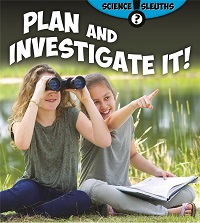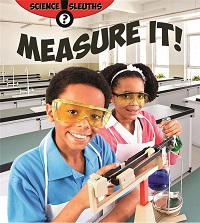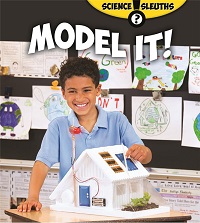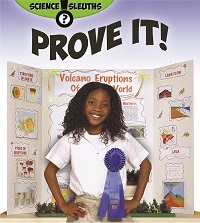| ________________
CM . . .
. Volume XXII Number 19. . . .January 19, 2016
excerpt:
Crabtree Publishing currently lists eight books in the “Science Sleuths” series. The four featured in this review genuinely help young school-aged children to think about what goes into planning a science investigation, including an experiment that is a fair test, to know the right tool and unit for measuring liquid and solid materials, to understand the importance of observational and measured data as evidence in constructing an answer to a research question, and to appreciate the value of the two-and three-dimensional models used by scientists as representations of very small, very large, or very old objects and events that are difficult, if not impossible, to study using the five senses. Shirley Duke and Reagan Miller, authors of Plan and Intestigate It!, begin with a scenario involving a brother and sister who have been ice skating and are drinking hot chocolate. One uses a cup that keeps the beverage warm and the other uses a cup that allows it to quickly cool off. They wonder if the cups are made of the same materials. In the subsequent 18 pages, Duke and Miller show how these children are thinking like scientists. Scientists use their senses to observe and gather information. They then use this gathered information to ask a question and plan an investigation to answer the question. The next phase is to carry out the investigation, recording observed and measured data. Conclusions are then constructed by using the data as evidence to answer the question. Finally, they communicate to share the results with other scientists. All 19 of these pages feature more than informational text. There are stock photographic images, coloured text boxes with statements or questions associated with the content in the adjacent text or image, and text circles with the title “Explore It!” (as in the first excerpt above). It is these additions that enable readers to practice what has been described. As one example, on page 6, an image of a girl looking through a telescope directed at the moon is overlaid in the top right with the text: “A scientists makes an observation: I can see more of the moon tonight than I could last night.” In the lower left of this image is a blue text box with a large blue question mark and the text “Then the scientist asks: Why does the moon seem to change shape each night?” This pattern (image, scientist’s observation, and scientist’s question) is repeated at the top of page 6 using a photograph of a wilted flowering plant in a pot. Below this is a photographic image of a cargo ship with the text, “A scientists makes an observation: That big, heavy boat floats in the water.” The text box with the question the scientist would ask is, however, missing. In its place is an “Explore It!” circle. The text in the circle is “Now it is your turn to think like a scientist! What question might a scientist ask after observing the boat in this picture?” A yellow box in the lower right corner of the image with a large yellow question mark and the text “Then the scientist might ask:” is followed by a blank line. The reader is expected to supply the question. Measure It!, written by Crystal Sikkens, Model It!, written by Robin Johnson, and Prove It!, written by Shirley Duke, follow a design similar to Plan and Intestigate It! . Sikkens, like Duke and Miller, provides a short narrative of two sisters sharing a bedroom who each measure the length of the room with one of their shoes. When they find out that Haily’s measure is 20 shoe lengths and Erin’s measure is 15, there becomes a justification for scientists, worldwide, using a common measuring system known as the metric system. Readers learn about the ruler and tape measure with meter, centimeter, and millimeter increments for determining the length, width or height of an object, the measuring cup and graduated cylinder with liter and milliliter increments for determining the volume of a liquid, and the thermometer in degrees Celsius for measuring how hot or cold a solid, liquid, or gas is. There is also information on how to record measured data so that data can be compared or used to make predications from the patterns identified (e.g., helping Gabriela predict the 08:00 temperature of the water in her swimming pool after identifying a two degree rise each morning for five days). Like Plan and Intestigate It!, there are opportunities to practice. “Explore It!” text circles are used, and the authors include a “Finding Capacity” activity where readers are to predict and determine the container with the largest internal volume, as well as a concluding assessment page where readers are to identify “The Right Tool” for each of five measurement problems. The image-scientist’s observation-scientist’s question pattern used by Duke and Miller is not incorporated in this book or in Model It! and Prove It!. Model It! helps readers to understand that scientists use models to learn about parts and aspects of the natural world that are difficult to observe. Robin Johnson, the author, also explains how models of the solar system, models of molecules, and models of systems like the organ systems in the human body, the plant and animal populations of an ecosystem, and the components of a weather system enable scientist to answer questions, construct explanations, and predict or forecast based on observed patterns. “Explore It!” activities encourage readers to compare a computer generated model of Earth with a globe and a world map to determine the benefits of using each type of model. Other activities have students using a model to determine night and day, building a model ecosystem, altering a model, and, finally, using a model to predict the consequences of removing a specific population from an ecosystem. Prove It! is focused on the requirement for scientists to base their explanations and arguments on observed and measured data. Data, not opinions, are the evidence used in making scientific claims and supporting an explanation. Shirley Duke describes the relationship between data and evidence and explanations, and she helps readers to understand that data used as evidence in formulating an explanation are not the same as an opinion. Duke also shows readers how to draw conclusions from data and explains the importance of sharing results and being respectful of others who have ideas that differ from one’s own. Each of these four books from the “Science Sleuths” series begins with a thorough table of contents and ends on pages 23 and 24 with a “Learning More” page with short lists of relevant books and websites and a final page with a glossary and index. The glossary is made up of the terms in boldface that were not defined within the text. These terms are also identified in the glossary as adjectives, nouns, or verbs. As mentioned in the introductory paragraph, the books reviewed here have been well written and well designed for their intended audience. There are, however, issues with the content that result in a recommended, rather than a highly recommended, review. The first, in Plan and Investigate It! states that a scientific hypothesis “can be tested in an experiment to see if it is correct” (p. 12). The second, in Model It!, states that a prediction is “to make your best guess what might take place next” (p. 9). The third, in Prove It!, states that a fact “is something that can be proven to be true” and that “the goal of a scientist is to prove his or her answer is the best one possible” (p. 22). The philosophy of science studies the features that distinguish science from all other disciplines. A “fact” in colloquial use refers to something that is true. Scientists do not usually talk about “facts” even though textbook authors sometimes do. Scientists resort to speaking and writing about specific observations. This is what was so valuable about the image-scientist’s observation-scientist’s question pattern used in this particular book by Duke and Miller. The focus was consistently on what was directly or indirectly observed. Predictions in science are informed. They are based upon a future event and what a scientist thinks will occur. As a result, tests of predictions show a prediction to be correct/right or incorrect/wrong. Hypotheses in science are formulated to explain one or more observations. A hypothesis is testable, but the results either support the hypothesis or fail to support the hypothesis. Hypotheses, as a result, are never considered to have been proven correct or proven incorrect. Proof is only possible in mathematics. In science, explanations are based on the best available evidence. History has shown, time and again, that explanations change with additional evidence. Recommended.
Barbara McMillan is a teacher educator and a professor of science education in the Faculty of Education, the University of Manitoba.
To comment on this title or this review, send mail to cm@umanitoba.ca.
Copyright © the Manitoba Library Association. Reproduction for personal use is permitted only if this copyright notice is maintained. Any
other reproduction is prohibited without permission.
CM Home |
Next Review |
(Table of Contents for This Issue - January 19, 2016.)
| Back Issues | Search | CM Archive
| Profiles Archive |



